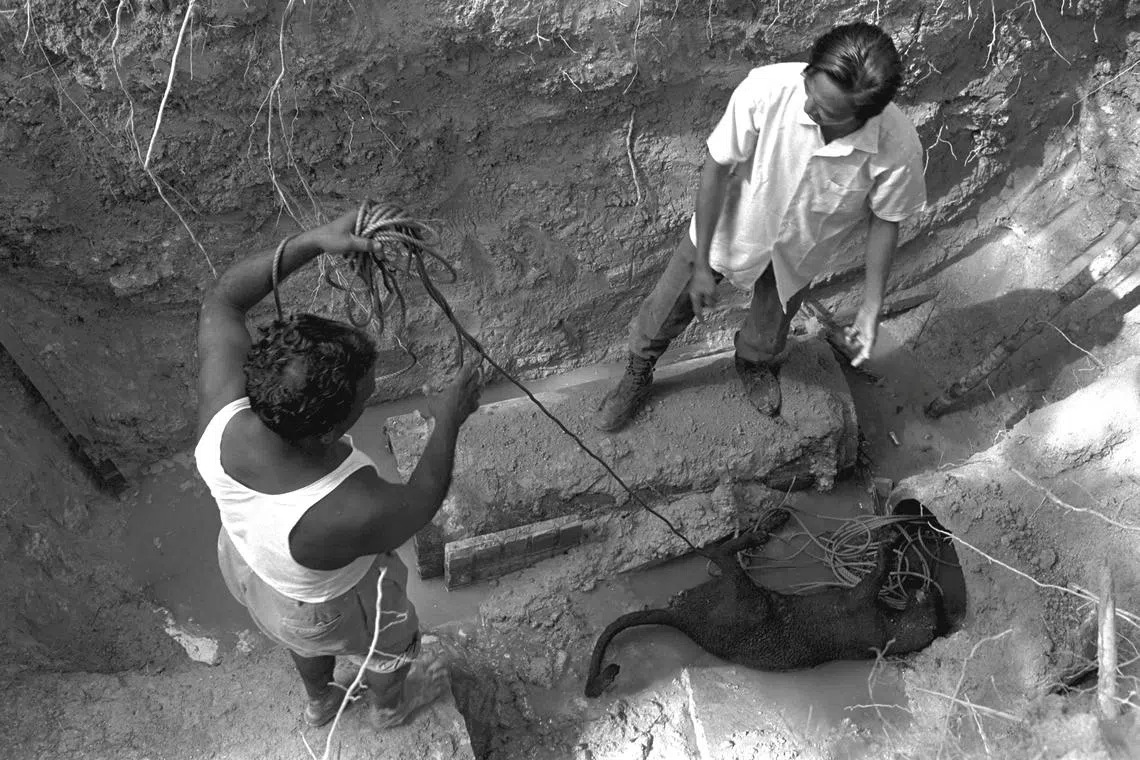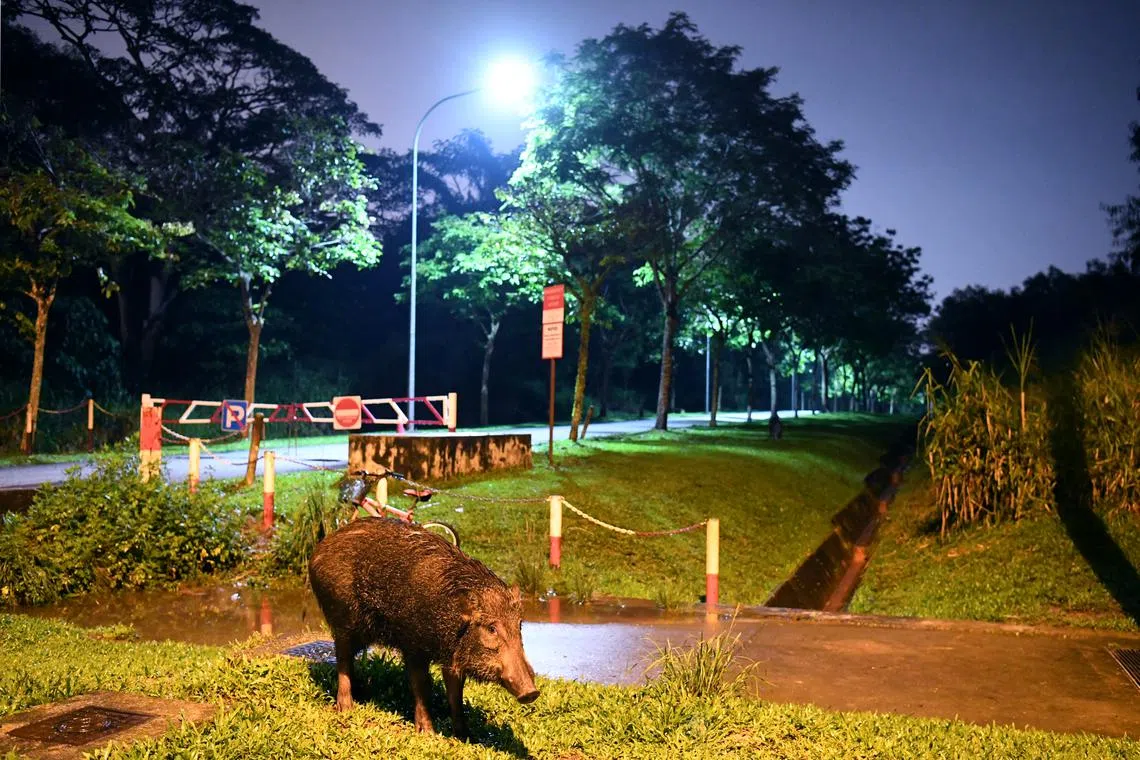Then and now: Days of being wild in Singapore
Whether 1845 or 2025, some things in Singapore never change. Snippets on how we reported them then and now.
Sign up now: Get ST's newsletters delivered to your inbox

Workers removing the body of Twiggy, a black panther, from an underground drain near the Singapore Turf Club. The animal had escaped from the Singapore Zoo in March 1973.
PHOTO: ST FILE
Follow topic:
In 2023, retail manager Durga Devi was walking back to her Bukit Panjang home when a wild boar charged at her.
The animal attacked her four times, flinging her from side to side before tossing her onto the road, The Straits Times reported. A passing jogger rushed to help.
She survived the attack but had to undergo multiple operations in what doctors described as one of the worst boar attacks they had seen.
Animal encounters, whether wild or captive, have long fascinated the public.
In March 1973, Twiggy the panther escaped from the Singapore Zoo. For 11 months, it roamed the island before it was found dead in an underground drain near the Singapore Turf Club.

A policeman advising pupils from Sembawang Hills Estate School to stay away from the jungle, as a panther that escaped from the Singapore Zoo had been spotted nearby. Two troops of Reserve Unit officers on duty and three police dogs were ordered to the scene in March 1973.
PHOTO: ST FILE
Two years later, in 1975, the police were on the alert for yet another panther, this one prowling the Tampines area after it was brought into Singapore illegally by an animal trader and escaped.
The female cat was eventually captured in Tanjong Rhu.
“PANTHER CAPTURED”, the headline screamed on the front page on July 4, 1975. “24-day reign of terror ends with three shots from tranquilliser gun”.
The panther had been spotted in the fuel tank of a ship under construction in Tanjong Rhu. It was captured by zoo officials while shipyard workers stood by to gawp at the drama.
From prowling panthers to rampaging boars, sightings of animals on the loose have long made headlines, underscoring the tension between urban development and natural habitats.
A dive into The Straits Times’ archives reveals a much wilder Singapore in the past, when tigers were a terror.
By the mid-19th century, Singapore had gained a grim reputation for tiger attacks. Historian C.M. Turnbull wrote in A History Of Modern Singapore 1819-2005 that tigers were said to carry off a victim a day.
A report on Dec 11, 1855, which chronicled the deaths of an agricultural labourer and a coolie, lamented: “How often are we compelled to record such verdicts. It reflects the greatest shame upon the Supreme Government that effectual means are not employed to relieve our dense jungles of ferocious Tigers.”
Tiger hunting became common, with rewards offered for kills.
In 1864, a reader named Carnie wrote in, describing how he had shot a tigress during an expedition before “she could make another spring”.
The menace extended to islands such as Pulau Ubin where a tiger killed two men in 1874. Those who killed tigers would sometimes take the carcasses to police stations to claim rewards, as Changi residents Ali and Mahomed did in 1898, when they hauled a dead tiger to the Rochore Police Station.
The last reported shooting of a wild tiger in Singapore was in Choa Chu Kang in October 1930.
But even in 1951, a tiger hunt was mounted near the Causeway after a sighting.
“It is believed that recent heavy RAF (the British Royal Air Force) bombing in south Johor may have driven the tiger out of the jungle and over the Causeway,” The Straits Times reported.
Today, as the city becomes more built-up, animal sightings are rising again, though they are not in the league of tigers and panthers.
In March 2025, The Straits Times reported a 55 per cent increase in calls to the Animal Concerns Research and Education Society between 2019 and 2024. The hotline received 15,203 calls in 2024 – up from 9,800 in 2019 – and now deals with an average of 10 cases a day.
Among the animals rescued: mynahs, pigeons, pythons, civets, monitor lizards and wild boars.

A wild boar spotted in Lorong Halus on Jan 12, 2021.
ST PHOTO: DESMOND FOO
Straits Times assistant news editor Audrey Tan, 34, who oversees environmental coverage, says Singapore now has experts with deep knowledge about certain wildlife species. Studies have also been done on why some animals, such as critically endangered pangolins, venture into urban areas.
All this has made coverage about wildlife more nuanced, she says.
Nature provides many benefits to urban dwellers, from the cooling effect of trees to the rest offered by parks and nature reserves, and reporting has evolved to highlight these intangible aspects, she adds.
Singapore is also slowly embracing nature in its land use plans – which is only a good thing.
From corals to armoured pangolins, otters to once-extinct hornbills, the natural world is an inescapable part of Singapore’s urban cityscape, down to people’s own backyards.
Ho Ai Li is assistant foreign editor at The Straits Times. She joined the paper in 2002 and has reported on both education and entertainment. A former foreign correspondent based in Taipei, then Beijing, she writes on pop culture, heritage and the history of Singapore.


